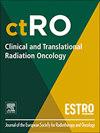立体定向放射治疗早期声门癌:这是“方法”吗?
IF 2.7
3区 医学
Q3 ONCOLOGY
引用次数: 0
摘要
在过去的几十年里,为了保护早期声门癌患者的声带功能,已经设计了几种选择,如经口激光显微手术,新的手术策略,如部分喉切除术和放射治疗(RT)。随着新的放射技术的发展,能够更准确地提供辐射剂量,并且有可能在不影响邻近危险器官(OARs)的情况下,每部分提供高剂量,立体定向全身放疗(SBRT)在这种疾病环境中得到越来越多的测试。我们的目的是阐明这一吸引人的战略,并强调最佳目标人口和具体的技术考虑。本文章由计算机程序翻译,如有差异,请以英文原文为准。
Stereotactic body radiotherapy for early glottic cancers: Is this “The Way”?
In the past decades, several options have been designed in order to preserve vocal function in patients with early glottic cancer, such as transoral laser microsurgery, new surgical strategies such as partial laryngectomy and radiation therapy (RT). With the development of new radiation techniques enabling a more accurate delivery of radiation dose, and the possibility to deliver high dose per fraction while sparing adjacent organs-at-risks (OARs), stereotactic body radiotherapy (SBRT) is being increasingly tested in this disease setting. We aimed to shed light on this appealing strategy, as well as to underline both optimal target population and specific technical considerations.
求助全文
通过发布文献求助,成功后即可免费获取论文全文。
去求助
来源期刊

Clinical and Translational Radiation Oncology
Medicine-Radiology, Nuclear Medicine and Imaging
CiteScore
5.30
自引率
3.20%
发文量
114
审稿时长
40 days
 求助内容:
求助内容: 应助结果提醒方式:
应助结果提醒方式:


